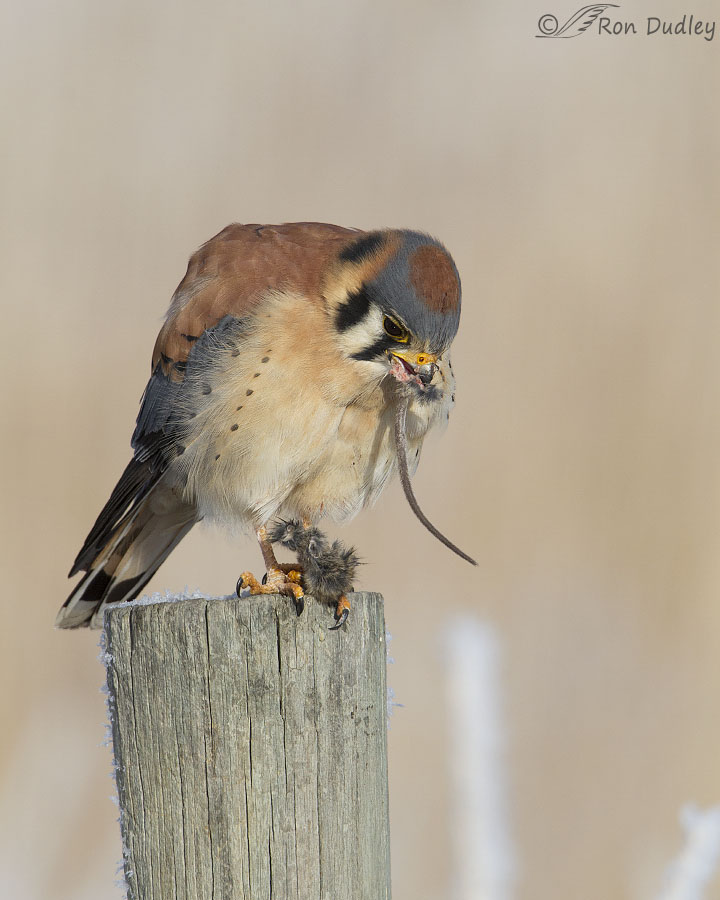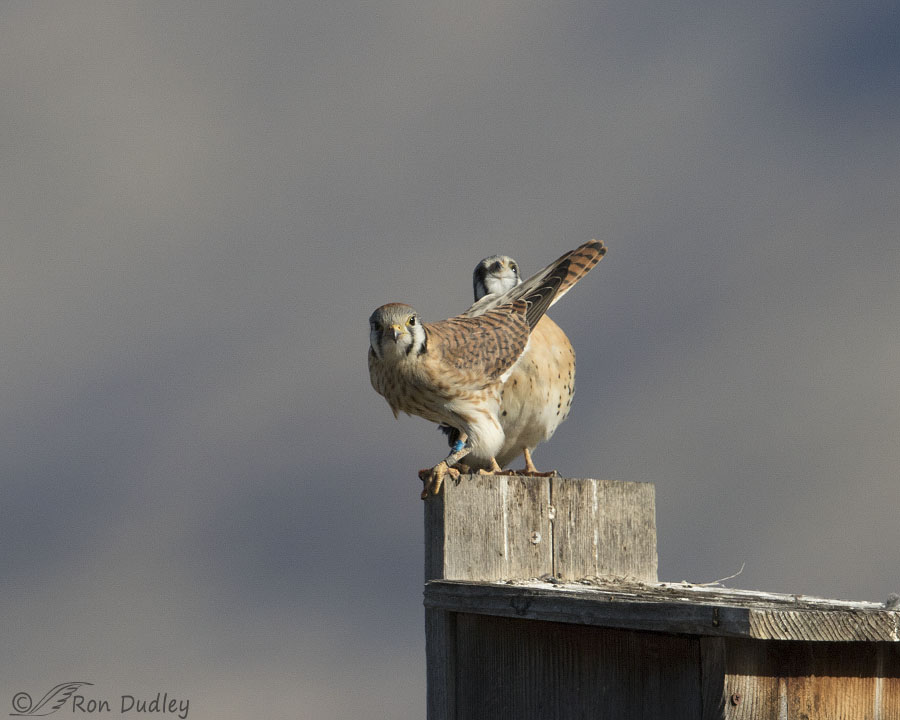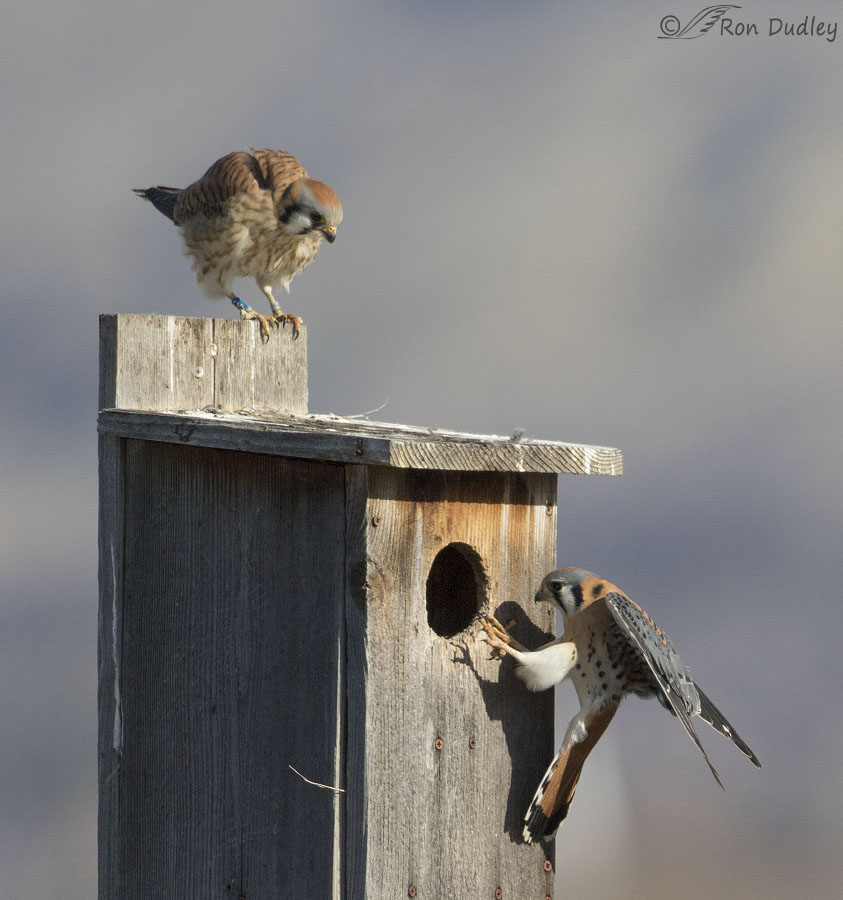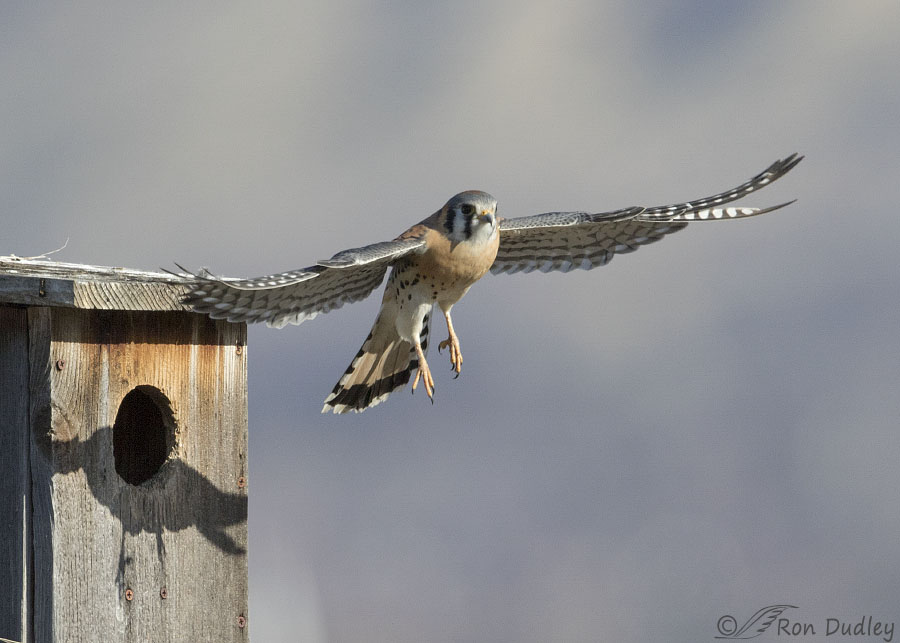And there’s more than one way to get it done.

1/1000, f/10, ISO 400, Canon 7D, Canon EF 500mm f/4L IS USM + EF 1.4 III Extender, not baited, set up or called in
In my experience kestrels often discard rodent tails but when it’s very cold and food is at a premium it’s another matter. In this older photo from my archives this male at Farmington was working hard to get one of those tails down the hatch but it wasn’t easy. He got it mostly down before he had to bring it back up again and start over. As you can see from the frost on the post and the vegetation in the background it was very cold that morning and he was determined to get every last warming calorie he could. I have many photos of the process but he kept his head down the entire time and this is one of the few shots that includes any light in the eye.
And yes, he eventually succeeded in swallowing it whole. Based on the length of the tail I believe the rodent was a mouse instead of a vole. I do see the occasional mouse at Farmington.
But there’s more than one way to get some tail at Farmington.

1/4000, f/6.3, ISO 500, Canon 7D, Canon EF 500mm f/4L IS II USM + EF 1.4 III Extender, not baited, set up or called in
Five days ago the banded female on the left was in a romantic mood and repeatedly stuck her tail in the face of her mate in an obvious effort to encourage his amorous instincts. He wasn’t interested at the moment, as indicated by his aloof reaction.

1/4000, f/6.3, ISO 500, Canon 7D, Canon EF 500mm f/4L IS II USM + EF 1.4 III Extender, not baited, set up or called in
At one point he flew down and entered the nest box, disappearing inside for a few moments.

1/3200, f/6.3, ISO 500, Canon 7D, Canon EF 500mm f/4L IS II USM + EF 1.4 III Extender, not baited, set up or called in
I kept trying to get flight shots of both birds as they entered and exited the box but they kept turning in the wrong direction to provide any light in the eye. Still, it was good practice for me and a test of my aging reflexes because kestrels are so very fast.
Much of the bird news around here is very discouraging this year but seeing kestrels pairing up for the last few weeks gives me some hope.
Ron
PS – This female was banded by HawkWatch International and she has been reported multiple times.


I saw my first Kestrel at a bird class I took last weekend. It was funny, it stayed in the same place forever as it seemed to be posing for us all. What a treat
Like the spread of the wings and the way the colors of the bird are echoed in the wooden nest box…nice!
You’re the first one to mention that shadow. It caught my eye immediately. Thanks, Patty.
1,0000 years ago, when I was a kid( turned 86 on the 8th), there was a radio program called, “The SHADOW” and they’d say, “Who knows? The Shadow knows” only I thought they were saying “the Shadow Nose”. It seemed a little strange, but I didn’t really question it.
Patty I used listen to that All the time when I was kid! WOW, does that bring back memories!!!!
Ron, great photos and an even greater story! Eating a mouse’s tail must be quite an experience for a bird. The thought of it sends my mind awhirl!
Hope you are feeling better and thanks for posting every day in spite of your pain.
Thanks very much, Alice.
Expected something totally different, especially after your recent Golden shot. Guess I have to pull my mind out of the gutter. The male leaving the nesting box is one cool shot. I like the curve of the primaries and that one primary that is sinkin’ low.
The male leaving the nesting box is one cool shot. I like the curve of the primaries and that one primary that is sinkin’ low.
Hope you’re feeling better today — both the back and the shingles.
You were expecting something different because I deliberately led you slightly astray with my title, Marty. My mind sometimes occupies the same gutter…
Still working on feeling better. It’s going to take a while I’m afraid.
“My mind sometimes occupies the same gutter…”
And this is why we’ve become friends over the Internet!
LOL Marty! And I’m right there in the gutter with y’all. Let’s have a PARTY!
Kestrels ROCK and what beautiful images! I think the male in the second image might be preening–he’s got that faraway look in his eyes, but it also looks like he’s routinely hanging out with this female. This time of year, raptors are just randy with repeated mating sessions, even after the eggs are laid.
I’ve got a similar photo to the first one with the male Kestrel I flew about 10 years ago when I lived in Dallas. He loved mice, hunted starlings and sparrows tenaciously and was overall just a cool bird (NOTE: I did NOT say the L[ittle} word! In reality, Kestrels are bigger than a pair of goldens mashed together.).
My computer did it again–I hit some combination of keys–I have no idea what the combination is–and it deleted a couple of paragraphs. I can’t remember what it deleted and it’s not available to get it back. Hate it when it does that!
I’ve got my Kestrel nest boxes installed on both the north and south sides of the house and I’m hoping I might attract a pair of nesters. They’re away from where the dogs are (albeit not very far), so we’ll see what happens. There are resident Kestrels here and few appropriate nesting sites–cavities are non-existent. I routinely see Kestrels in the field so I’m hopeful. There’s also a pair of redtails looking for a new home, but again, there are few appropriate sites.
Nope, he wasn’t preening, Laura. He was just moving his head out of the way of her tail and ignoring her advances at the same time. I’m sure he took her up on her offer many times while I wasn’t there though… Thanks, Laura.
Hahaha! Very clever pun and great pics as usual. Thanks for the education.
Thank you, Joanne.
YUK!!!
Great title. LOL
Interesting pictures Ron. I took a picture recently of a Kestrel with a mouse he had caught on the golf course here. He took it to the top of a pine tree and was still in the process of killing it before he flew off so I never got to see whether he ate the tail. I just this year joined up with the Kestrel restoration group here in Prescott who provides the boxes for them and monitors their actions all through the mating and breeding season.
Everett Sanborn, Prescott AZ
Glad to hear about you joining the kestrel support group, Everett. I hope it and others are able to do some good.
I’m heading to Prescott here soon. Looking forward to checking out some new birds. Nothing against my California birds

Fun! Also good shots of the Kestrels…… Probably precious few calories in the tail, BUT – need that “tail” to get the other “tail” even if that male wasn’t interested at the moment!
Also good shots of the Kestrels…… Probably precious few calories in the tail, BUT – need that “tail” to get the other “tail” even if that male wasn’t interested at the moment!  I haven’t heard that expression in years……. They are fast and, unless I’m paying attention, I often miss them with other small birds around. Didn’t even know they were around here until after starting to visit your Blog!
I haven’t heard that expression in years……. They are fast and, unless I’m paying attention, I often miss them with other small birds around. Didn’t even know they were around here until after starting to visit your Blog!
“I haven’t heard that expression in years”
Judy, Growing up in Cut Bank variations of that phrase were often used by male teenagers in my day. Of course I never used it…
Right………….
*Cough. Cough. Cough*
Wonderful shots Ron. I hope they will be successful.
Photographed a male in 14′, but haven’t seen one since. Sad!
Thanks, Dick. Sadly kestrels are declining in large portions of their range. HawkWatch International has implemented a study that will hopefully provide valuable information as to why. This banded female is presumably part of that study.
When you get our age my mind reverts back to “I can remember when, how many, where”.
This year unlike other years there has been a real concern that feeder birds are down in numbers and especially chickadees. Something is going on, but no one knows the what it is, just supposition and or speculation.
Ron kestral are very prevalent here I see lots of them !!all around my neighborhood .. along with red tailed hawks love your pictures . My kestral female disappeared a year ago .. so don’t know if I will have babies in my box this year.. I miss her roosting on my rafters .. I have a screech owl in my other box ., I had a brown creeper in my yard .. going up and down in my cottonwood tree .. I never really had more than an occasional chickadee in my yard so I wouldn’t know about they’re numbers but plenty of kestral here
Ron I have lots of kestrals in my neighborhood along with red tailed hawks .., love your pictures.. The female kestral that roosted in my deck disappeared about a year ago ..I’m thinking the harrier finally got her .. she was always chasing him off and than he would turn around and go after her.. so unless the male brings a new female to box might not have any little Kessies this year.. but they are doing well in western Colorado